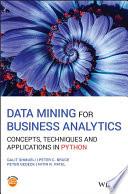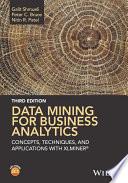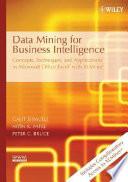
Data Mining for Business Analytics
Concepts, Techniques and Applications in Python
Data Mining for Business Analytics: Concepts, Techniques, and Applications in Python presents an applied approach to data mining concepts and methods, using Python software for illustration Readers will learn how to implement a variety of popular data mining algorithms in Python (a free and open-source software) to tackle business problems and opportunities. This is the sixth version of this successful text, and the first using Python. It covers both statistical and machine learning algorithms for prediction, classification, visualization, dimension reduction, recommender systems, clustering, text mining and network analysis. It also includes: A new co-author, Peter Gedeck, who brings both experience teaching business analytics courses using Python, and expertise in the application of machine learning methods to the drug-discovery process A new section on ethical issues in data mining Updates and new material based on feedback from instructors teaching MBA, undergraduate, diploma and executive courses, and from their students More than a dozen case studies demonstrating applications for the data mining techniques described End-of-chapter exercises that help readers gauge and expand their comprehension and competency of the material presented A companion website with more than two dozen data sets, and instructor materials including exercise solutions, PowerPoint slides, and case solutions Data Mining for Business Analytics: Concepts, Techniques, and Applications in Python is an ideal textbook for graduate and upper-undergraduate level courses in data mining, predictive analytics, and business analytics. This new edition is also an excellent reference for analysts, researchers, and practitioners working with quantitative methods in the fields of business, finance, marketing, computer science, and information technology. “This book has by far the most comprehensive review of business analytics methods that I have ever seen, covering everything from classical approaches such as linear and logistic regression, through to modern methods like neural networks, bagging and boosting, and even much more business specific procedures such as social network analysis and text mining. If not the bible, it is at the least a definitive manual on the subject.” —Gareth M. James, University of Southern California and co-author (with Witten, Hastie and Tibshirani) of the best-selling book An Introduction to Statistical Learning, with Applications in R
- ISBN 13 : 1119549841
- ISBN 10 : 9781119549840
- Judul : Data Mining for Business Analytics
- Sub Judul : Concepts, Techniques and Applications in Python
- Pengarang : Galit Shmueli, Peter C. Bruce, Peter Gedeck, Nitin R. Patel, Peter C. Bruce, Peter Gedeck, Nitin R. Patel,
- Kategori : Mathematics
- Penerbit : John Wiley & Sons
- Bahasa : en
- Tahun : 2019
- Halaman : 610
- Google Book : http://books.google.co.id/books?id=ZEewDwAAQBAJ&dq=intitle:Data+Mining&hl=&source=gbs_api
-
Ketersediaan :
This is the sixth version of this successful text, and the first using Python.


